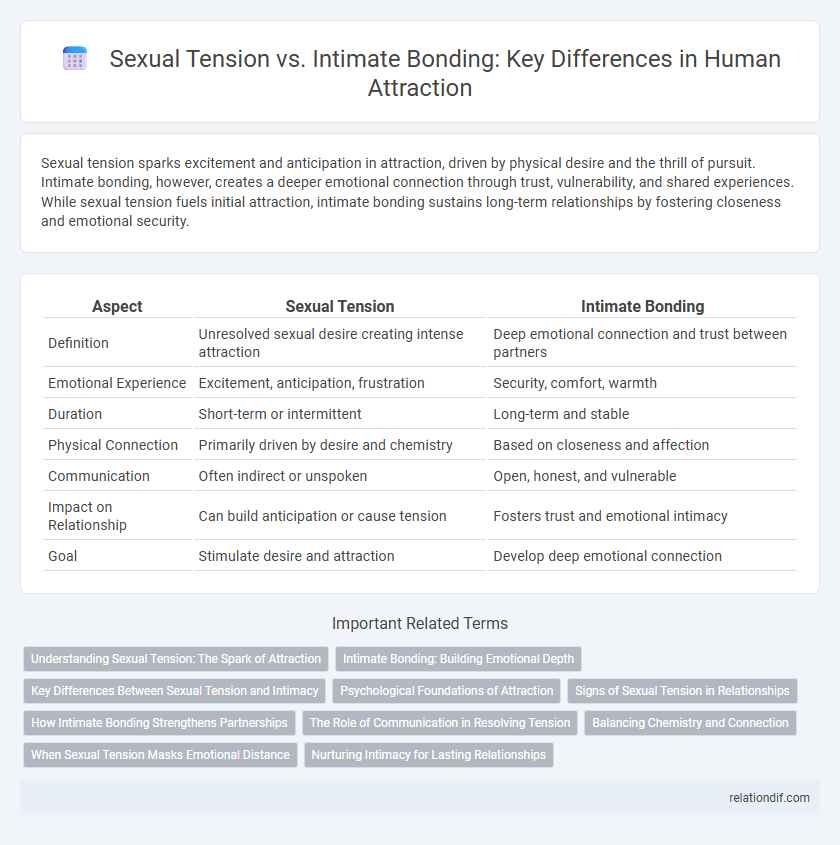Sexual tension sparks excitement and anticipation in attraction, driven by physical desire and the thrill of pursuit. Intimate bonding, however, creates a deeper emotional connection through trust, vulnerability, and shared experiences. While sexual tension fuels initial attraction, intimate bonding sustains long-term relationships by fostering closeness and emotional security.
Table of Comparison
| Aspect | Sexual Tension | Intimate Bonding |
|---|---|---|
| Definition | Unresolved sexual desire creating intense attraction | Deep emotional connection and trust between partners |
| Emotional Experience | Excitement, anticipation, frustration | Security, comfort, warmth |
| Duration | Short-term or intermittent | Long-term and stable |
| Physical Connection | Primarily driven by desire and chemistry | Based on closeness and affection |
| Communication | Often indirect or unspoken | Open, honest, and vulnerable |
| Impact on Relationship | Can build anticipation or cause tension | Fosters trust and emotional intimacy |
| Goal | Stimulate desire and attraction | Develop deep emotional connection |
Understanding Sexual Tension: The Spark of Attraction
Sexual tension ignites the initial spark of attraction through unspoken desires and heightened anticipation, creating a magnetic pull between individuals. Unlike intimate bonding, which develops through shared vulnerability and emotional connection, sexual tension thrives on mystery and the thrill of potential intimacy. Recognizing this dynamic helps clarify the difference between fleeting desire and deeper relational attachment.
Intimate Bonding: Building Emotional Depth
Intimate bonding fosters a deeper emotional connection that transcends physical attraction, creating a foundation of trust and understanding essential for long-lasting relationships. This emotional depth strengthens communication and empathy, enabling partners to support each other's growth and navigate challenges together. Developing intimate bonds enhances relationship satisfaction and emotional resilience, distinguishing it from fleeting sexual tension.
Key Differences Between Sexual Tension and Intimacy
Sexual tension is characterized by physical attraction and unspoken desire, often fueled by anticipation and uncertainty, whereas intimate bonding involves emotional closeness, trust, and vulnerability. Sexual tension is usually temporary and surface-level, creating excitement through attraction without deep connection, while intimate bonding fosters long-term relational stability through shared experiences and genuine understanding. Understanding these distinctions clarifies how physical chemistry differs from emotional intimacy in romantic relationships.
Psychological Foundations of Attraction
Sexual tension arises from unspoken desire and anticipation, activating dopamine pathways that heighten arousal and focus attention on a potential partner. Intimate bonding involves oxytocin and vasopressin release, fostering trust, emotional security, and long-term connection beyond physical attraction. Psychological foundations of attraction rely on the balance between these neurochemical processes to transition from initial desire to deep relational attachment.
Signs of Sexual Tension in Relationships
Sexual tension in relationships manifests through prolonged eye contact, subtle yet charged physical proximity, and heightened awareness of each other's presence. Persistent teasing, flirtatious body language, and a palpable undercurrent of desire often signal unresolved sexual attraction between partners. These signs create an electrifying atmosphere that distinguishes sexual tension from deeper intimate bonding, which is characterized by emotional connection and trust.
How Intimate Bonding Strengthens Partnerships
Intimate bonding fosters deep emotional connections by promoting trust, vulnerability, and empathy, which are crucial for long-term relationship stability. Unlike fleeting sexual tension, intimate bonding nurtures mutual understanding and shared experiences that create lasting attachment. Consistent emotional support and communication during intimate bonding significantly strengthen partnership resilience and satisfaction.
The Role of Communication in Resolving Tension
Effective communication plays a crucial role in resolving sexual tension by allowing partners to express desires, boundaries, and emotions clearly, fostering mutual understanding. Open dialogue helps transform raw sexual energy into intimate bonding, strengthening emotional connections and trust. By addressing misunderstandings and expectations through honest conversations, couples deepen their relationship and enhance both attraction and intimacy.
Balancing Chemistry and Connection
Sexual tension sparks immediate excitement through physical attraction and desire, while intimate bonding builds deeper emotional connection and trust over time. Balancing chemistry and connection requires nurturing both physical attraction and open communication to sustain a fulfilling relationship. Prioritizing emotional intimacy alongside sexual energy enhances long-term compatibility and relationship satisfaction.
When Sexual Tension Masks Emotional Distance
Sexual tension often creates a false sense of closeness that can mask underlying emotional distance in relationships, leading partners to confuse physical attraction with genuine intimacy. Neuroscientific studies highlight that while sexual arousal activates reward centers in the brain, it does not engage the same pathways responsible for deep emotional bonding and trust. Recognizing this distinction is crucial for fostering authentic connections that balance both physical desire and emotional vulnerability.
Nurturing Intimacy for Lasting Relationships
Sexual tension ignites initial attraction, but nurturing intimacy builds a foundation for lasting relationships through deep emotional connection and trust. Prioritizing open communication, shared experiences, and vulnerability fosters a bond that transcends physical desire and supports long-term partnership stability. Consistent emotional support enhances intimacy, promoting sustained relationship satisfaction and resilience.
Sexual tension vs Intimate bonding Infographic

 relationdif.com
relationdif.com